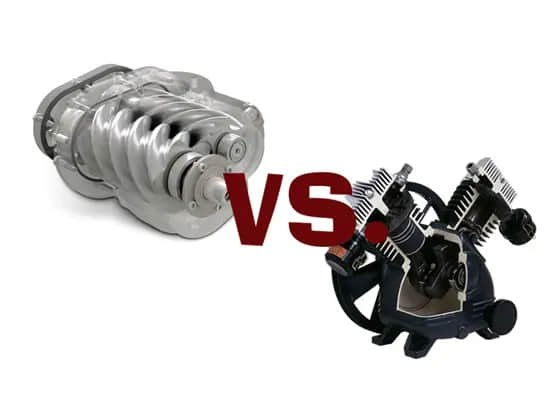When it comes to air compressors, the two most popular configurations are piston type and rotary screw compressors. The choice between the two often depends on your specific needs and the nature of your operations. This guide aims to provide you with the necessary information to help you make an informed decision.
Understanding Piston and Rotary Screw Compressors
Piston or reciprocating air compressors are the most common air compressors worldwide. They operate on the same mechanical principle as a combustion engine, with a crank turning a connecting rod, which moves the piston up and down inside the cylinder head. The air is compressed as the piston is driven upward, converting electric energy into kinetic energy.
On the other hand, rotary air compressors are typically configured with two interlocking helical rotors with a small gap between them. The air enters through an inlet valve and is compressed in the space between both screws when they turn to reduce the volume and increase pressure.
Comparing Piston and Rotary Screw Compressors
When comparing piston and rotary screw compressors, several factors come into play:
- Maintenance and wear and tear: Piston compressors have more moving parts, leading to greater wear and tear and more frequent maintenance. However, due to their simple mechanical setup, they are easier to maintain and fix.
- Operating temperature, noise, and vibration: Rotary compressors typically have lower operating temperatures, generate less noise, and vibrate less than piston compressors.
- Air flow and operation time: Piston type compressors cannot run non-stop due to the risk of overheating and are typically run at only 50% of their total CFM or air flow capacity. In contrast, rotary screw compressors can run continuously.
- Space required and energy efficiency: Rotary screw compressors usually take up less space than piston compressors and are more energy-efficient.
- Pressure ratio and volume: Piston compressors offer a greater compression range and more flexibility in terms of pressure ratio and capacity. However, rotary compressors have a much greater volume capacity.
- Oil carry-over: Piston compressors typically discharge more oil into the stream of compressed air than rotary screw compressors do.
- Price: Due to the factors mentioned above, piston compressors are generally less expensive than rotary screw compressors.
Conclusion
Choosing between a piston and a rotary screw air compressor depends on your specific needs and operational requirements. If you have any lingering questions, feel free to contact the team of experienced air compressor experts at Compressor World.
FAQs
- What are the main differences between piston and rotary screw air compressors? The main differences lie in their operation, maintenance requirements, operating temperature, noise levels, air flow and operation time, space requirements, energy efficiency, pressure ratio and volume, oil carry-over, and price.
- Which air compressor is more energy-efficient? Rotary screw compressors are generally more energy-efficient than piston compressors.
- Which air compressor requires more maintenance? Piston compressors typically require more maintenance due to their greater number of moving parts.

